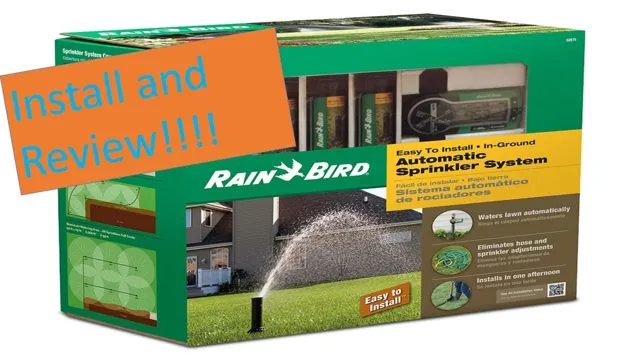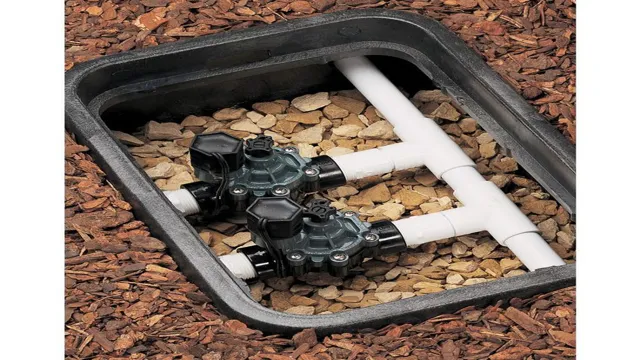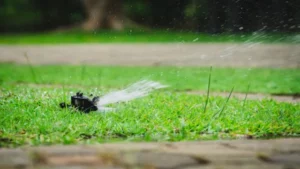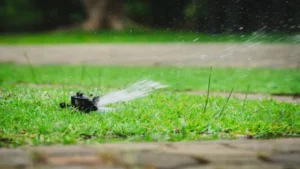If you’re tired of manually watering your lawn or garden, the Rainbird sprinkler system might be just what you need. This innovative system uses advanced technology to deliver water to your landscape precisely where and when it’s needed. But how do you use it? In this blog post, we’ll guide you through the setup and usage of a Rainbird sprinkler system, step-by-step.
From installation and programming to maintenance and troubleshooting, we’ve got you covered. So, let’s dive in and explore the world of Rainbird sprinklers and take the first step towards a healthier and greener landscape.
Understanding Your Rainbird Sprinkler System
Learning how to use a Rainbird sprinkler system can help you better understand how to keep your lawn and garden healthy and green. The first step is to familiarize yourself with the different zones and types of irrigation your system offers, such as spray heads, rotor heads, and drip irrigation. Once you understand this, you can begin programming your system to water according to your specific needs, taking into account factors such as soil type, sun exposure, and plant type.
Be sure to also regularly check and maintain your sprinkler heads to ensure efficient and effective watering. With some practice and attention, using your Rainbird sprinkler system can become second nature and help you achieve a lush and healthy landscape.
Identify the Different Zones
If you have a Rainbird sprinkler system installed in your yard, it’s essential to understand the different zones to ensure your lawn and garden get the proper water they need. Each zone refers to a specific area that has its own set of sprinklers. You can typically identify the different zones by examining your sprinkler heads and determining which areas they cover.
It’s important to note that each zone may have different watering needs, depending on factors such as sun exposure, soil type, and plant types. By understanding your zones, you can program your sprinkler system to water each area accordingly, promoting healthy growth and preventing over or under-watering.

Familiarize Yourself with the Controller
To keep your lawn or garden healthy and beautiful, it’s important to have an efficient sprinkler system. Rainbird sprinkler systems are a popular choice for their quality and durability. However, before you start using your system, it’s important to understand the controller.
Familiarizing yourself with the controller will make it easier to set up and adjust your sprinkler system as per your needs. The controller is the brain of the system and controls watering schedules, duration, and frequency. It’s vital to input accurate information about your lawn’s size and vegetation types to help the controller determine the optimum watering schedule for your lawn.
Additionally, it’s important to identify the main valves and areas that require watering and configure the controller accordingly. By setting up the controller properly, you can ensure optimum water usage and preserve the health of your lawn or garden, without wasting water.
Check the Water Pressure
When it comes to maintaining your Rainbird sprinkler system, it’s important to keep an ear out for any unusual sounds that could indicate a problem, such as low water pressure. With low water pressure, the sprinkler heads won’t function as well, resulting in patchy or uneven watering of your lawn. There are a few things you can do to check the water pressure and make sure everything is running smoothly.
Start by turning on the main water valve and observing the flow of water from the sprinkler heads. If the water flow seems weak or inconsistent, it could be a sign of low pressure. Another way to check is by using a water pressure gauge, which can be found at most hardware stores.
Simply connect the gauge to the closest outdoor faucet and turn on the water. The gauge will then measure the water pressure, which should be between 40-60 psi for optimal sprinkler performance. Checking your water pressure regularly will help ensure that your Rainbird system is working its best and keep your lawn looking lush and healthy all season long.
Setting Up Your Rainbird Sprinkler System
Setting up your Rainbird sprinkler system is not as difficult as you might think. First, you’ll need to locate the main water supply to your yard. Once you’ve found this, you’ll need to install a backflow prevention device to ensure that water doesn’t get contaminated.
Next, look for the appropriate location to install your sprinkler system controller. You may want to install it inside your home or in a weatherproof box outside. After installing your controller, you can start laying out your watering zones.
It’s important to measure your lawn and garden areas accurately to ensure that each zone gets sufficient water. Finally, you can add the sprinkler heads and make sure that everything is working correctly. By following these simple steps, you can have a fully functional Rainbird sprinkler system that will keep your lawn and garden looking great all year round.
Set Watering Schedule and Duration
One of the great features of a Rainbird sprinkler system is the ability to set up a watering schedule and duration. This ensures that your lawn or garden receives the right amount of water at the right time, preventing over- or under-watering. To start, determine how often you want to water your plants and at what time of day.
This will depend on factors such as the type of plants you have and the climate in your area. Once you have a schedule in mind, use the Rainbird app or controller to set the watering duration for each zone. This can also be adjusted easily if you find that your plants need more or less water.
With a Rainbird system, you can take the guesswork out of watering and ensure that your outdoor space stays healthy and beautiful.
Configure Each Zone’s Settings
Setting up your Rainbird sprinkler system is important to ensure that each zone is receiving the optimal amount of water without wasting valuable resources. One crucial step in this process is configuring each zone’s settings. This involves setting up the zone’s specific watering schedule, the duration of each watering session, and the frequency at which the system waters the area.
These settings can be adjusted based on the type of plants, soil, and weather conditions in each zone. It’s essential to take these factors into consideration to ensure that your plants receive the appropriate amount of water to thrive. With Rainbird’s easy-to-use programmable interface, setting up your system is a breeze.
Simply input the specific settings for each zone and let the system do the work for you. By properly configuring each zone, you can enjoy lush, healthy plants, and save water in the process.
Ensure Proper Placement and Alignment of Sprinkler Heads
Rainbird sprinkler system When setting up your Rainbird sprinkler system, it is essential to ensure proper placement and alignment of sprinkler heads. It’s easy to overlook this step, but it can make a significant difference in the quality of your irrigation. Make sure you place the sprinkler heads in the appropriate location to get the proper coverage for your lawn and garden.
The water pressure also affects the sprinkler heads’ performance to ensure the heads are level and installed correctly. If the pressure is too high, the water can overshoot, and if it’s too low, the water won’t go as far as it’s supposed to. By ensuring proper alignment and placement, you can guarantee that the water reaches all parts of your lawn and garden, thereby keeping your plants healthy and vibrant.
It’s imperative to take the time to do this step correctly, as it will save you a lot of time and money in the long run. With a properly functioning Rainbird sprinkler system, you’ll be able to enjoy a lush, vibrant lawn and garden throughout the years without any worry.
Maintaining Your Rainbird Sprinkler System
Maintaining your Rainbird sprinkler system is crucial in ensuring your lawn and garden remain healthy and well-watered. Firstly, make sure to check your system’s timer and schedule settings every season to ensure it meets the changing weather and growth patterns. Secondly, check your sprinkler heads regularly – they can become clogged, damaged, or misaligned and affect the water distribution in your yard.
Thirdly, inspect your system’s pipes and valves for any leaks or damage – this can lead to water waste and also damage your lawn or home’s foundation. Finally, consider getting professional maintenance and upkeep services to ensure your Rainbird sprinkler system is in top working order. With a little care and regular maintenance, your Rainbird sprinkler system can last for decades and keep your lawn and garden lush all year round.
So, if you want to have a well-maintained and functional sprinkler system, keep in mind these easy to follow tips on how to use Rainbird sprinkler system.
Inspect and Clean Sprinkler Heads Regularly
Maintaining Your Rainbird Sprinkler System Routine inspection and cleaning of your rainbird sprinkler heads are crucial in keeping your irrigation system in optimal condition. Over time, debris such as dirt, grass clippings, and leaves can accumulate and clog your sprinkler heads, causing uneven watering and dry patches in your lawn. Regularly inspecting your sprinkler heads can help identify any damage that may have occurred during landscaping or mowing and replace them if necessary.
Cleaning out the debris from your sprinkler heads will help prevent blockages and ensure that your lawn is getting consistent, adequate water coverage. Neglecting to maintain your sprinkler system can lead to costly repairs down the line, so it’s essential to make it a routine part of your yard maintenance. With a little effort and attention, you can keep your lawn green, lush, and beautiful all season long.
Adjust Sprinkler Heads as Needed
One crucial aspect to maintaining your Rainbird sprinkler system is adjusting the sprinkler heads as needed. Over time, your sprinkler heads may become tilted or misaligned, leading to uneven watering and potential under or over-watering of certain areas of your lawn. Checking and adjusting your sprinkler heads can be easily done by turning on your system and observing the spray pattern.
If you notice dry spots or areas with excessive water, it’s time to grab a screwdriver and adjust the head accordingly. By taking the time to properly adjust your sprinkler heads, you can ensure that your lawn receives the necessary amount of water to thrive. Plus, it can save you money in the long run by preventing wasted water and the potential need to replace dead or dying grass.
So, grab your screwdriver and take a walk around your yard to ensure your Rainbird sprinkler system is in tip-top shape!
Tips for Maximizing Your Rainbird Sprinkler System
If you own a Rainbird sprinkler system, you have made a wise investment in your landscape’s health and beauty. However, to maximize its effectiveness, you need to know how to use Rainbird sprinkler system. Firstly, make sure you have set the timer correctly to water your lawn or garden at the most opportune time of the day.
Overwatering can lead to fungus and runoff, so ensure that you are using the right amount of water for the particular area you are watering. If you have any questions about watering schedules or amounts, consult with professionals or your local garden center. Adequate coverage is crucial to ensuring all areas get the right amount of water, so double-check that the sprinkler heads are adjusted correctly.
Additionally, be aware of any leaks or clogs in the system that may hinder water flow. Regular maintenance on your Rainbird sprinkler system will extend its life and ensure optimal performance. By following these tips, you can maximize the benefits of your Rainbird sprinkler system and achieve a healthy, beautiful landscape.
Install Rain Sensors to Save Water and Money
Rainbird sprinkler system, rain sensors, save water, save money Installing rain sensors is an excellent way to maximize the efficiency of your Rainbird sprinkler system. These devices automatically turn off your sprinklers when it rains, preventing unnecessary watering and saving you both water and money. Rain sensors are easy to install and come in various types to fit different sprinkler models.
Another tip for maximizing your system is to schedule watering in the early morning or late evening to avoid water loss through evaporation during the day. Additionally, make sure to adjust the sprinkler heads regularly to ensure even coverage and prevent water waste. With these easy tips, you can get the most out of your Rainbird sprinkler system and keep your lawn healthy while saving water and money.
Consider Drip Irrigation for Gardens or Shrubs
If you’re looking to save water and still keep your garden or shrubs healthy, a drip irrigation system may be the perfect solution for you. Unlike traditional sprinklers that tend to waste a lot of water and can damage plants with their forceful stream, drip irrigation delivers water directly to the roots of your plants through a network of tubes and emitters. This allows for more efficient watering and reduces the risk of plant diseases caused by excess moisture.
But what if you already have a Rainbird sprinkler system in place? Don’t worry – you can still maximize its efficiency with a few simple tips. First, make sure your sprinkler heads are positioned correctly and aren’t watering any unnecessary areas like sidewalks or hardscapes. Second, adjust the flow rate to match your plants’ needs and the weather conditions.
Finally, consider installing a rain sensor that will automatically turn off your sprinklers when it starts raining, saving you even more water and money. By combining a Rainbird sprinkler system with drip irrigation and these tips, you can ensure that your garden or shrubs receive the right amount of water while conserving this precious resource. Give it a try and see the difference for yourself!
Periodically Test and Adjust Your System for Optimal Performance
Rainbird sprinkler system If you have a Rainbird sprinkler system, it’s important to periodically test and adjust it for optimal performance. Here are some tips for maximizing your system’s effectiveness. First, check the water pressure and adjust it if necessary.
If the pressure is too high, it can cause the sprinkler heads to spray unevenly or even damage them. Next, check the direction and range of the sprinkler heads to make sure they’re hitting the intended areas and not wasting water. You may need to adjust the angle or change the nozzles to achieve better coverage.
Also, be sure to check for leaks and repair them promptly to prevent water waste. Finally, consider installing rain sensors or upgrading to a smart controller that adjusts watering based on weather conditions and soil moisture levels. By taking these steps, you can ensure that your Rainbird sprinkler system is working efficiently and effectively, saving water and keeping your lawn and garden healthy.
Conclusion
In summary, using a Rainbird sprinkler system is as easy as letting Mother Nature take the reins (or rather, the sprinkler controller). With automated settings and precise targeting, this system expertly mimics the gentle and nourishing flow of rain, delivering just the right amount of water to your lawn and garden. So go ahead, sit back and relax as your plants are hydrated to perfection.
With a Rainbird sprinkler system, you can treat your garden like royalty without breaking a sweat.”
FAQs
What is a Rainbird sprinkler system?
Rainbird sprinkler system is an automated irrigation system for your lawn and garden.
How does a Rainbird sprinkler system work?
The system uses a network of pipes and sprinkler heads to distribute water evenly across your lawn and garden. A timer or controller unit activates the system at specified intervals.
How do I install a Rainbird sprinkler system?
Installing a Rainbird sprinkler system involves planning the layout, digging trenches, laying pipes, installing sprinkler heads, and setting up the controller. It is recommended to hire a professional for the installation process.
How do I program the Rainbird sprinkler system?
The programming of the Rainbird sprinkler system requires setting up watering schedules, zones, and run times. The controller unit comes with a user manual that explains the programming process.
How do I adjust the sprinkler heads?
To adjust the sprinkler heads, turn the adjustment screw located on the top of the head to change the spray pattern. You can also adjust the distance and spray angle using the nozzle.
How often should I water my lawn with a Rainbird sprinkler system?
The frequency of watering depends on various factors, such as the climate, soil type, and plant type. However, a general rule of thumb is to water once or twice a week for around 30-45 minutes per zone.
How do I maintain my Rainbird sprinkler system?
Regular maintenance of your Rainbird sprinkler system involves checking for leaks, clogs, and broken sprinkler heads. You should also adjust the watering schedules based on seasonal changes in weather and plant growth.






